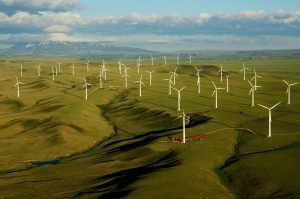Each wind turbine has a rated capacity, which depends on the length of the rotor blades and the power rating of the generator. The turbine produces at the rated capacity at a certain wind speed.

Wind power utilization
As the wind speed constantly fluctuates, even to a large extent, wind turbines generally run on partial load most of the time. Accordingly, the number of full load hours is generally quite low. Onshore wind turbines have full load hours of roughly 1800, offshore turbines feature considerably higher values of above 3000.
Basically, the number of full load hours can be influenced by design parameters, such as the length of the rotor blades and the rated power of the generator. Hence, it is an economic parameter, where the different design parameters dependent on the economic framework conditions for wind power.
Due to the laws of fluid mechanics, the maximum efficiency of wind turbines is 59 percent. Losses in technical processes of a wind turbine, such as friction, lead to lower real-life efficiency values of about 50 percent.
Several wind turbines that are constructed and clustered at one location are called a wind park or wind farm. The distance between the single turbines has to be sufficient. Otherwise the turbines in the lee or the wake of other wind turbines receive lower wind speeds.
In wind parks joint access to the grid is possible. Additional advantages can be leveraged during the construction phase of the wind park, as one connecting road can be used to develop several locations at once.
With this post our tutorial on power plant technologies comes to an end.



